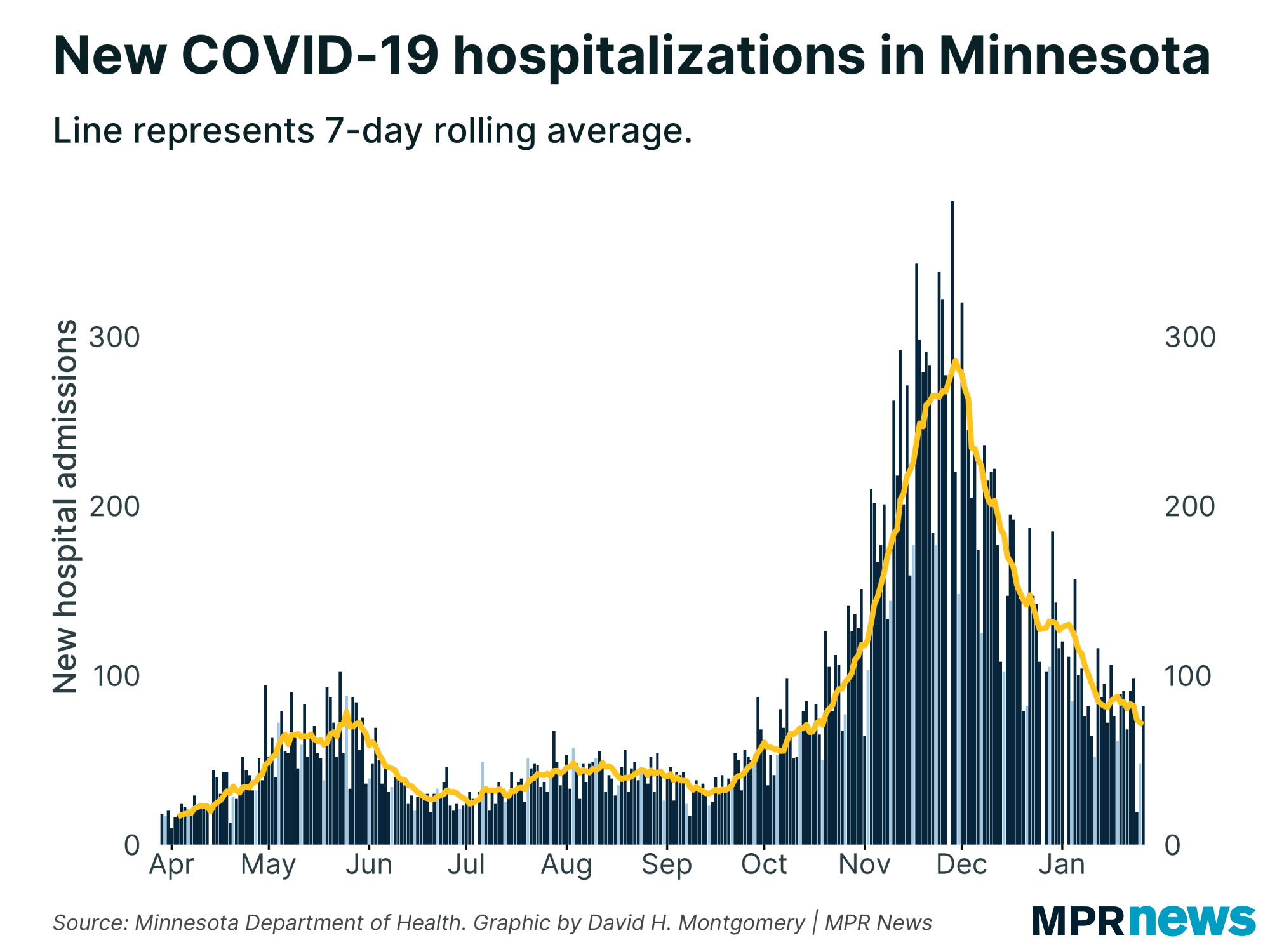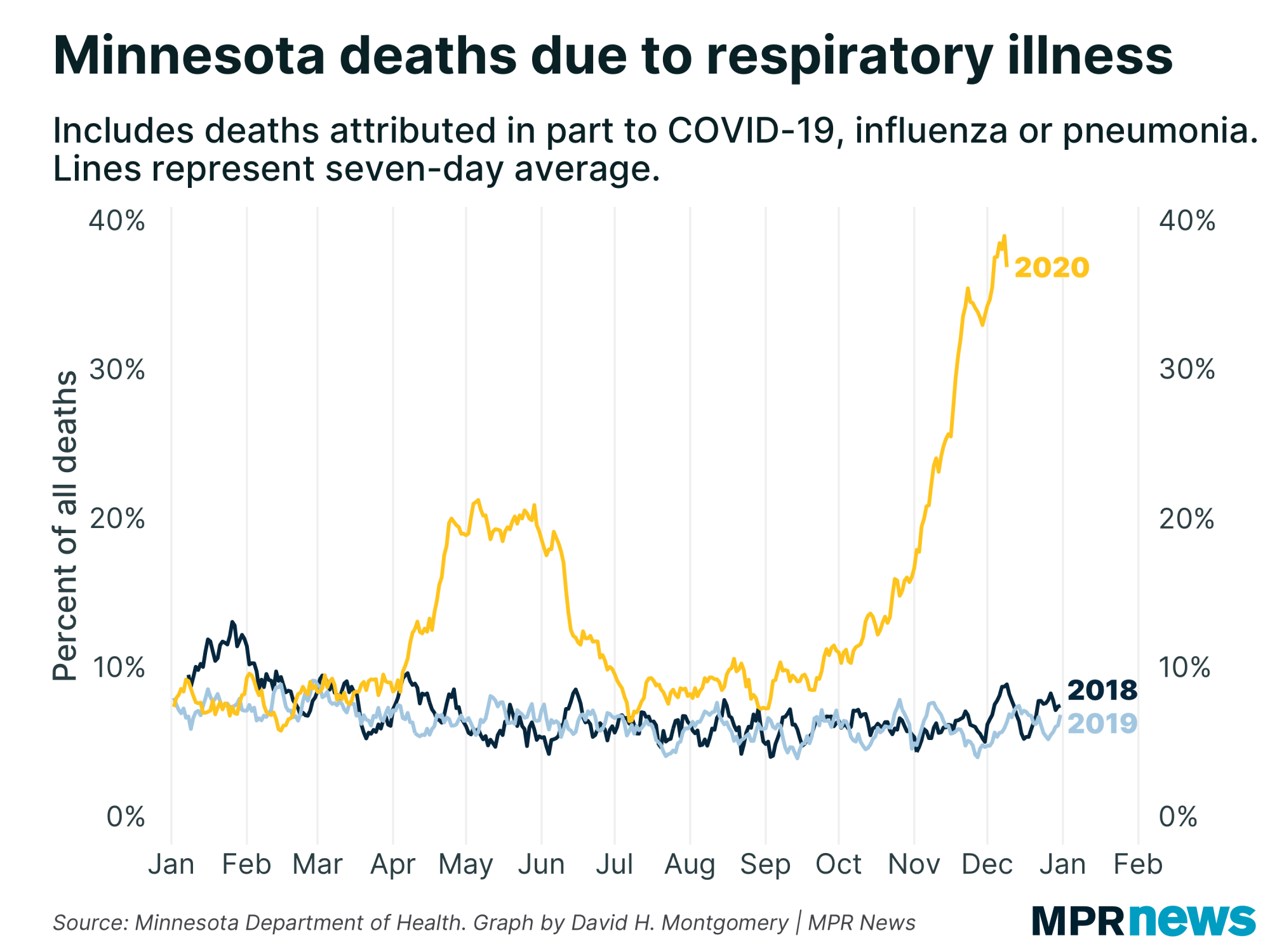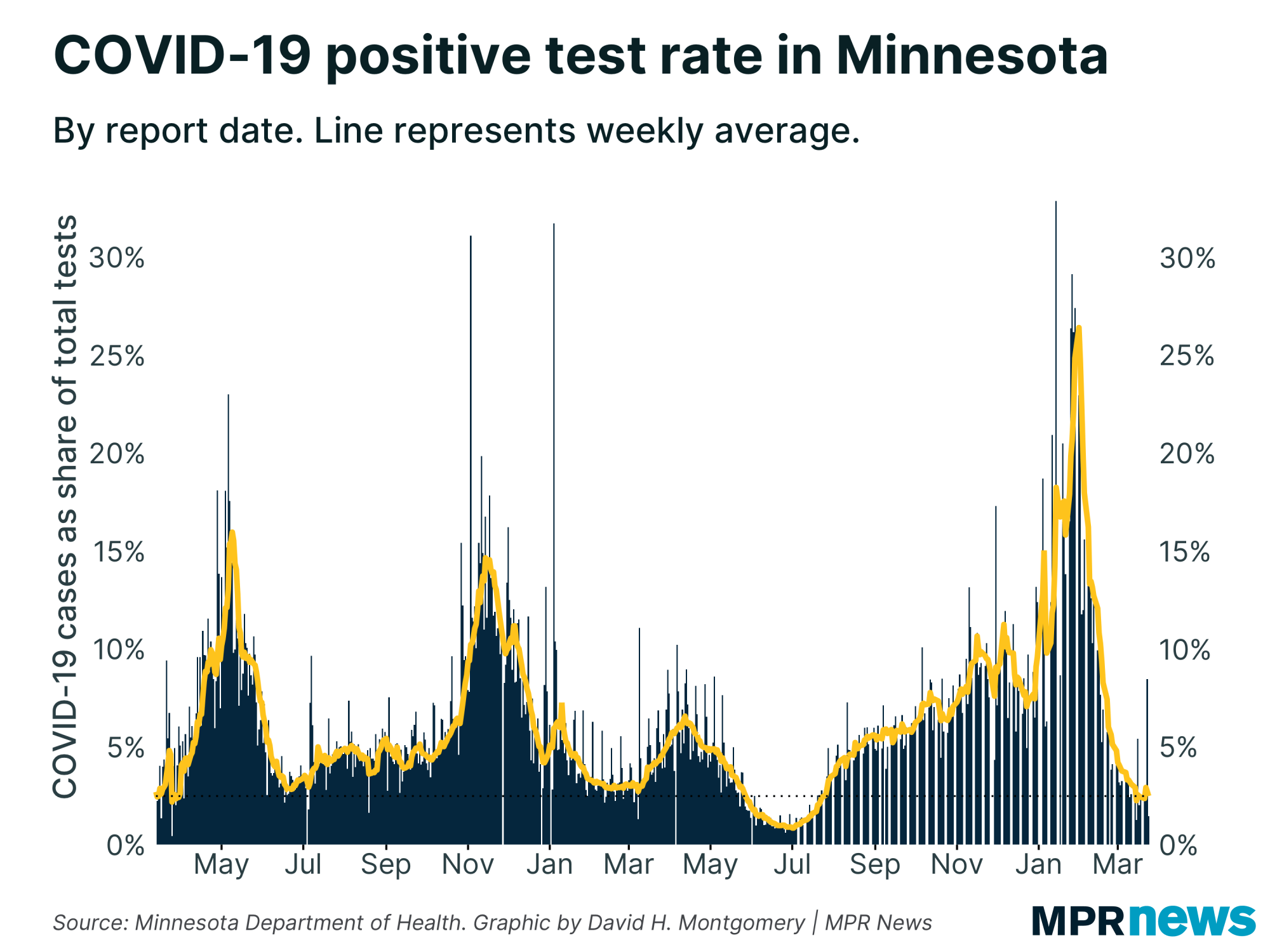Dec. 2 update on COVID-19 in MN: 5K new cases, 77 deaths

Go Deeper.
Create an account or log in to save stories.
Like this?
Thanks for liking this story! We have added it to a list of your favorite stories.
Updated: 2:50 p.m.
COVID-19 continues to run a hard-to-chart course in Minnesota following the Thanksgiving holiday.
The state Health Department on Wednesday reported 5,192 newly confirmed or probable cases of the disease, along with 77 more deaths — the second-highest daily toll reported in the pandemic.
New hospital admissions retreated from Tuesday’s record seven-day average, but hospitalization levels remain high. More than 1,700 people were in hospitals with COVID-19 as of Tuesday; more than 350 needed intensive care.

Officials continue to brace for another expected wave of COVID-19 cases, hospitalizations and deaths in coming weeks originating from Thanksgiving gatherings.
Turn Up Your Support
MPR News helps you turn down the noise and build shared understanding. Turn up your support for this public resource and keep trusted journalism accessible to all.
Of the 327,477 confirmed or probable cases identified to date, about 87 percent have recovered to the point they no longer need to be isolated.

The COVID-19 deaths reported Wednesday raised Minnesota’s toll to 3,692. Among those who’ve died, about 67 percent had been living in long-term care or assisted living facilities; most had underlying health problems.

More than one-third of all recent deaths in Minnesota are tied to COVID-19.

Overall, respiratory illnesses tend to account for around 5 to 10 percent of all deaths in Minnesota, with minor fluctuations around the year.
In Minnesota’s May COVID-19 wave, respiratory illnesses were accounting for around 20 percent of deaths. Now it’s even higher: nearly 40 percent of all deaths in Minnesota in recent weeks have been attributed to a respiratory illness such as COVID-19, influenza or pneumonia.
‘Challenging weeks ahead’
The newest numbers come a day after state public health authorities sketched out their plans to distribute vaccines as soon as they’re available. Federal vaccine approvals could start as soon as next week.
“We have been talking about the light at the end of the tunnel. It's there and it’s getting closer all the time. But we do have to stay the course a bit longer before we reach it,” Kris Ehresmann, the state’s infectious disease director, said Tuesday.

The short-term direction of the pandemic, however, is still unclear. Analysts have cautioned not to read too much into the most recent figures because of the long holiday weekend.
“These daily numbers can and do fluctuate” but “we do remain in a very critical stage of the pandemic,” Minnesota Health Commissioner Jan Malcolm told reporters Tuesday. “We are still in for some very challenging weeks ahead in terms of hospital capacity.”
Officials continue to plead with Minnesotans to wear masks in public gathering spaces, socially distance, stay home if you don’t feel well and otherwise stay vigilant against the spread of COVID-19.
On Monday, Walz said he’d likely call on Minnesotans not to travel or gather for Christmas.
“I think the guidance around Thanksgiving is going to be very similar around Christmas,” he told reporters Monday, adding there was “little reason” to expect a change in the trajectory of the virus in the next four weeks.
Caseloads spread across age groups
New cases have been climbing over the past month among all age groups.
People in their 20s still make up the age bracket with the state’s largest number of confirmed cases — nearly 64,000 since the pandemic began, including more than 34,000 among people ages 20 to 24.

The number of high school-age children confirmed with the disease has also grown, with more than 25,000 total cases among children ages 15 to 19 since the pandemic began.
The numbers help explain why experts remain particularly concerned about teens and young adults as spreaders of the virus.
Although less likely to feel the worst effects of the disease and end up hospitalized, experts worry youth and young adults will spread it to grandparents and other vulnerable populations.
It’s especially concerning because people can have the coronavirus and spread COVID-19 when they don’t have symptoms.
Walz said recently the state has data showing infection rates rising around bar and restaurant activity after 9 p.m. among young adults, noting that people who have the virus but don’t have symptoms may be unwittingly spreading it.
It’s one of the reasons he’s ordered a ban on in-person service at bars and restaurants until Dec. 18.
Virus surges across rural Minnesota
Regionally, central and northern Minnesota have driven much of the recent increase in new cases while Hennepin and Ramsey counties show some of the slowest case growth in the state.

The fastest growing outbreaks remain largely along the state’s western border with the Dakotas, where the virus is spreading unchecked. But new cases are rising everywhere in Minnesota.
Collectively, rural areas continue to report the most new COVID-19 cases per capita.

Latino cases climb
In Minnesota and across the country, COVID-19 has hit communities of color disproportionately hard in both cases and deaths. That’s been especially true for Minnesotans of Hispanic descent for much of the pandemic.

Distrust of the government, together with deeply rooted health and economic disparities, have hampered efforts to boost testing among communities of color, officials say, especially among unauthorized immigrants who fear their personal information may be used to deport them.
Similar trends have been seen among Minnesota’s Indigenous residents. Counts among Indigenous people jumped in October relative to population.
Cases among all races and ethnicities continue to rise, although currently the growth is slowest among Black Minnesotans, who reported the most new COVID-19 cases per capita for much of the spring and summer.
‘The honest, horrible truth’
State health systems are straining to staff hospital beds as COVID-19 cases grow and doctors, nurses and other care workers struggle to cope with illness among their own families and colleagues.

State officials for weeks have been raising concerns that health care workers are being sidelined by COVID-19, either by illness or exposure in their communities, or else having to care for loved ones.
Malcolm on Tuesday said 56 health care operations in the state have “staffing support needs … It is very definitely an ongoing challenge.”
The public needs to know the state’s health system is under serious stress, Dr. Cindy Firkins Smith, president of Carris Health in western Minnesota, told MPR News Monday.
“We have to tell it like it is. We have to give people the honest, horrible truth of what we're facing,” she said. “We have to tell them, ‘If you don't do it — if you, the public, don't do what you can do — we can't save you because there are only so many people to take care of people out there.’”
Developments around the state
Gophers-Northwestern game canceled over COVID
The University of Minnesota has canceled its Saturday Big 10 football game with Northwestern University due to COVID-19.
The game will not be rescheduled and will be ruled a no contest, per Big Ten policy this season, the U said in a statement Monday, adding it still hopes to play a game at the University of Nebraska on Dec. 12. The U canceled its game at Wisconsin last week.
Since Nov. 19, the Gophers football program has recorded 47 positive cases, which includes 21 student-athletes and 26 staff members, the university athletics department said.
— MPR News Staff
COVID-positive inmate in Rush City prison dies
An inmate at the Minnesota Correctional Facility in Rush City has died after being diagnosed with COVID-19.
The Department of Corrections reported Sunday that the 57-year-old man died late Saturday at a St. Paul hospital. It's the fifth COVID-related death of a Minnesota state prison inmate during the pandemic — and the first from the Rush City facility.
The man’s name has not been released.
Officials said Sunday that the Rush City prison has 49 inmates and 21 staff members with active COVID-19 cases. More than 150 other inmates at the facility have tested positive and recovered, according to data on the department's website. The facility houses about 900 inmates.
Two inmates from other prison facilities are in critical condition and being treated on ventilators at hospitals due to COVID-19, the department said Sunday. Several Department of Corrections employees also are hospitalized.
The department said it has "conducted comprehensive testing of all incarcerated people and staff in our facilities," and taken other steps to prevent and slow the spread of the coronavirus.
— MPR News Staff
U to research COVID-19 outbreaks and immigrants
A new research center at the University of Minnesota will focus on control of the COVID-19 outbreaks in immigrant communities.
The Centers for Disease Control and Prevention has given the U of M a $5 million grant to set up the National Resource Center for Refugees, Immigrants and Migrants. It will work with local health departments to train providers on culturally appropriate care.
Shailey Prasad, a professor of medicine who is co-leading the center, said evidence shows that the virus has disproportionately affected communities of color. Many, he said, "are essential workers like farm workers or food processing plant employees and have challenges to maintain social distancing, for example, or maybe challenges in accessing health care.”
The center plans to identify barriers and help with mitigation.
— Riham Feshir | MPR News
Top headlines
Caregivers challenged by latest pandemic surge: State officials say this is a critical time in the coronavirus outbreak. This week, four Mayo Clinic staff members who have been working with COVID-19 patients since the beginning of the pandemic talked about their experiences on a call with reporters.
States with few coronavirus restrictions are spreading the virus beyond their borders: Lax states are attracting shoppers and students from stricter neighbors — and sending back COVID-19 cases. The imbalance underscores the lack of a national policy.
Minnesota short-term budget picture brightens; long-term deficit remains: The improved outlook — a $641 million surplus through June instead of a shortfall four times as big that was projected back in May — could lead to a quicker deal on a relief package for businesses and workers coping with fallout from COVID-19 and related restrictions.
Most MN students buckle up for another stretch of distance learning: With COVID-19 cases, deaths and hospitalizations on the rise, nearly 60 percent of Minnesota K-12 students are currently in distance learning — more than double the rate from early October. The switch is again heaping pressures on students, families and educators.
COVID-19 in Minnesota
Data in these graphs are based on the Minnesota Department of Health's cumulative totals released at 11 a.m. daily. You can find more detailed statistics on COVID-19 at the Health Department website.


